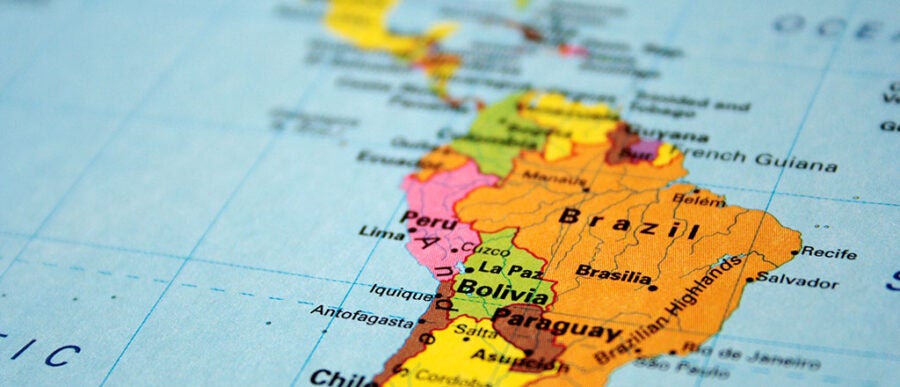Only a few years ago, commodity exports from Latin America were booming, as analysts heralded the arrival of the region’s major economies – including Brazil, Chile, Colombia and Mexico – into the narrow circle of leading emerging nations.
No longer. On the whole, Latin America suffered a 14% decline in exports last year, as the nations of South America, in particular, suffered an even more precipitous 21% drop in their collective exports. 2015 marked the third-straight year for such a decline, with the fall-off intensifying and spreading to virtually all nations in the region, according to the Inter-American Development Bank (IDB).
In response, Barcelona, Spain-based LatinFocus Consensus Forecasts has slashed the region’s GDP growth forecast to only 0.6% in 2016. “There are no signs of change in price trends for commodities markets, and a slowdown in economic activity is expected to continue in China and in Latin America,” according to the IDB. The only bright spot is Mexico and Central America, where stronger demand from the United States “could lend dynamism to exports” adds the IDB. “This trade contraction, which is the worst since the 2009 collapse, is a wake-up call on the need to implement export diversification policies,” says Paolo Giordano, principal economist of the Bank’s Integration and Trade Sector and coordinator of the report.
Obviously, for the countries that depend so much on commodities, the decline in commodity prices is worrisome, says Wharton management professor Mauro Guillen. “For Mexico and Colombia, the situation is much better because they have a more diversified export structure by product and they depend more on the United States or Europe for export markets…. The United States, within the global context, is not doing that bad [economically].”
A Double Whammy
Felipe Monteiro, senior fellow at Wharton’s Mack Institute for Innovation Management, explains that the commodity-based growth that Latin America has experienced provides a double whammy to the region. “It is not a balanced trade and it is also very volatile, since it relies so much on commodity prices [which are volatile]. You benefit from those years of growth, but you also have those big moments of depression. When you have trade relationships which are not so heavily dependent on commodities, those prices vary in a much more limited way. Commodity prices move so quickly — one way or another.”
“This trade contraction … is a wake-up call on the need to implement export diversification policies.” –Paolo Giordano
Oil-exporting countries have been affected the most by the sharp drop in petroleum prices. According to the IDB, Venezuela (minus 49%) and Colombia (minus 35%) posted the biggest contraction rates in their overall exports in 2015, measured in dollar volumes, followed by Bolivia, Ecuador, and Trinidad and Tobago. El Salvador and Guatemala were the only two countries where exports rose, due to a strong increase in their sugar shipments to China. Latin America’s overall exports to China plunged 14%, while expectations of a rebound of exports to the United States were neutralized mostly by a drop in the value of oil, which resulted in sales to the U.S. shrinking by 7%.
Walter Kemmsies, senior economist at Moffatt & Nichol, an infrastructure development consultancy, distinguishes between demand trends for industrial commodities and agricultural commodities. On the one hand, industrial commodity exports include energy commodities, metals and aggregates. Agricultural exports include everything from grains, sugars and seeds to protein.
With respect to industrial commodity exports, demand for Latin American iron ore in China has lately been growing more slowly than mining companies in such countries as Brazil, Chile and Peru had expected a few years ago. Kemmsies notes, “Globally, about $4.5 trillion in debt has been issued during the last three or four years to build new mines and connections between mines and ports, railroads — a lot of investment [in] producing things [using] iron ore. Four or five years ago, in Brazil there was enough port export capacity developed that could handle tonnage that was four or five times greater than the total amount of tonnage handled around the world [before then]. That’s when [the mining and energy firms owned by Brazilian billionaire] Eike Batista blew up — and he turned out to be the canary in the mine, literally.”
Global mining giants such as Rio Tinto and BHP “were overextended in investment capacity — and the consumption growth just wasn’t there to absorb that,” Kemmsies adds. “We have a supply-demand imbalance in iron ore. We also have one in copper and many metals. So with the dollar getting stronger, and China’s demand for industrial metals getting weaker, the prices collapsed.”
On the other hand, he notes, “Agricultural trade has held up decently. Those parts of Latin America that are dependent on agricultural exports are doing okay. But those parts that are dependent on industrial raw materials and energy are not okay.”
“Those parts of Latin America that are dependent on agricultural exports are doing okay. But those parts that are dependent on industrial raw materials and energy are not okay.” –Walter Kemmsies
He adds, “Agricultural prices have also come down, but not to the extent that industrial prices have come down. Before China exploded on the scene, the average price of soy beans was $2 to $4 a bushel; but the price spiked [at $17 a bushel] in 2012 and has now declined to between $8.75 to $9.50. [However,] if you compare soy with where it was 10 to 15 years ago, it is still two to three times higher. Oil today is back to where it was in 2004-2005.”
Brazil: Multiple Uncertainties
For Brazil, by far the region’s most populous nation and largest economy, the new year brings both economic uncertainty and political instability. On the one hand, the Brazilian economy contracted a whopping 4.5% in the third quarter of 2015 from a year earlier. The International Monetary Fund forecasts that for 2015, Brazil’s gross domestic product will have shrunk by 3% followed by another 1% in 2016. “[Brazil starts] the year with a lot of uncertainty,” says Monteiro. “There are a lot of question marks.”
Late in 2015, finance minister Joaquim Levy resigned, replaced by planning minister Nelson Barbosa. Levy, who served less than one year as finance minister, favored fiscal austerity and other reforms designed to make Brazil’s economy more competitive. Levy’s tenure was marked by constant conflict within the administration’s economic team. In 2015, Brazil’s economy plunged into a recession. Meanwhile, inflation soared to over 10%, and the country was downgraded to speculative credit status by two major ratings agencies, Fitch and Standard & Poor’s. Levy pushed for a bigger surplus while Barbosa argued for a smaller margin of savings for the next year.
President Dilma Rousseff favored Barbosa’s position, asking Congress to trim the expected surplus from the equivalent of 0.7% of gross domestic product to 0.5%. Meanwhile, Rousseff has faced charges of massive corruption as more information surfaces about the connections between state-owned oil giant Petrobras and politicians during her time chairing the board of directors. Last December, the country’s supreme court ruled that Rousseff cannot be impeached under current proceedings aimed to remove her from office. The judges decided that a new vote on impeachment must be held, with the Senate taking the final decision this year.
Brazil has a lot of problems, Guillen notes, “but the immediate problem is inflation getting out of control. With the economy in a deep recession, there is no clear way out. Commodity prices are flat or, in some cases, continue to go down.” In Brazil, as in most of these other economies, he says, “the problem is that they didn’t make the investments they should have made in the boom years when things were going well; when they were flush with commodity money. That is the tragedy in all of this.”
Monteiro adds, “When you look at 2016, it is clear that a lot of those things that would hopefully have been [solved by now] are still pressures that are ongoing. And there is no clarity in terms of the time horizon [for concluding] the political gridlock — despite the fact that the impeachment process has formally started. There is no clear indication of what the final outcome will be, or how long it will take.”
“[Brazil starts] the year with a lot of uncertainty. There are a lot of question marks.” –Felipe Monteiro
Despite such uncertainties, Monteiro cautions against viewing Brazil’s troubled economy as the twin brother of neighboring Argentina. While both countries have suffered from the decline in global commodity prices, Monteiro notes that Brazil’s “industry and business sector are much more diversified, and on a different scale.” He adds that “while Argentina had so many years of deterioration, the good news is that we have some clarity in terms of the new government [in that country]. And it is promising that [newly elected Argentine president Mauricio Macri] is a pro-business guy, and we have hope in that sense. But the Argentine economy has deteriorated much more [than Brazil has]. Comparing Argentina with Brazil — yes, Brazil has deteriorated, but it is on a different level. It is not a country that has been suffering so much as Argentina, which has been kept out of financial markets and has had high restrictions for imports.”
Monteiro continues, “I see a different bright side for both of them. On the one hand, Argentina has … some new hopes and new government, but the situation has deteriorated much more. In Brazil, you don’t have that hope yet; people don’t know exactly what’s going to happen.” However, in terms of fundamentals, Brazil is a much stronger economy, he adds.
For Brazil, 2016 will also offer a bittersweet opportunity to host the Summer Olympic Games in Rio, which will take place at a juncture when Brazil’s economic stature and political stability are both at risk. Even the economic impact of the 2016 Olympics has been widely called into question of late, given the downturn in the country’s economy.
Guillen agrees with that view, noting that the current mood in Brazil is “very pessimistic” because inflation is out of control, and the President has very little margin to persuade people to be involved with reforms because her approval rating is extremely low; less than 10% percent. “The dire economic situation is, for the most part, driven by the strong dollar and the problems in China,” he notes. “Then, you [also] have the domestic political situation.”
Kemmsies notes that the funds used for constructing Olympic facilities would have been much better spent to construct infrastructure for roads, railroads, ports and so forth. According to Monteiro, the Games “will have only a very limited impact” on the country’s lagging economy. “We will have some positives, but it will be more for Rio [de Janeiro]. [Unlike the World Cup of 2012], the Olympics are in a single city, so they are very concentrated. The hope is twofold: On the one hand, in terms of the infrastructure that is going to be there after the games, Rio is going to benefit. And for Brazil, which is in the middle of so much bad news, I’m sure it is going to be a moment when the country is going to [pull] together. Hopefully by then, we will have more clarity [on the political situation]. But I wouldn’t put too much weight on the idea that the Olympics will somehow offset the negative effects” of the current crisis.
Even Chile, another rising star among emerging nations during the boom years, is no longer facing smooth sailing, notes Guillen. “Chile used to be a country that was performing relatively well, but again, it was an illusion to a certain extent. They were relying on very high commodity prices. Chile is not much better off,” he said, despite its diversification into producing the high-quality wines and fruits that it ships to the United States and other foreign markets.



